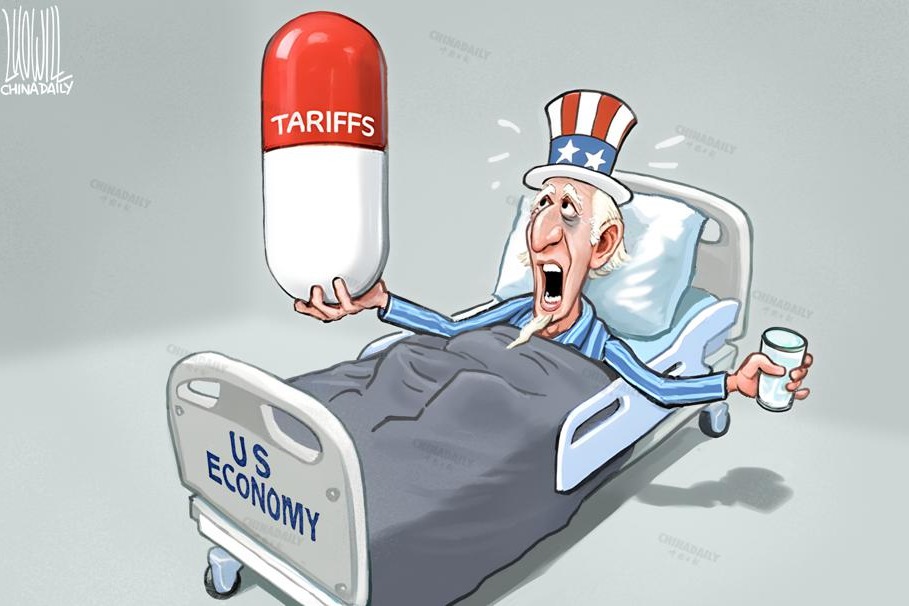Wider opening-up to realize market potential
By Zhang Monan | China Daily | Updated: 2022-02-10 07:14

To expand domestic demand and further tap the potential of a super-large market, China, which is home to the largest middle-income group in the world, should further open up its economy to make the domestic market more attractive to high-quality global resource elements and build the world's largest resource element market.
Domestic market benefits from wider opening-up
China's domestic market has largely benefited from wider opening-up in recent years. To begin with, China has actively promoted trade and investment facilitation, and has fulfilled the commitments it made to the World Trade Organization when it joined the world trade body in 2001, substantially reduced institutional costs on imports, and gradually lowered the overall tariff levels.
During the 13th Five-Year Plan (2016-20) period, China lowered import tariffs on 1,585 items, reducing overall tariffs from 9.8 percent to 7.5 percent. And while China's trade structure has become more balanced, constantly increasing imports are providing more and more high-quality products and services for domestic consumers.
Second, China has greatly broadened foreign businesses' access to the domestic market. Since the 18th National Congress of the Communist Party of China in November 2012, the authorities have been opening up new areas to foreign investment, promoting important institutional innovations, including shortening the negative lists. In 2013, the Third Plenary Session of the 18th CPC Central Committee adopted the "Decision of the Central Committee of the Communist Party of China on Several Major Issues Concerning Comprehensively Deepening the Reform", which formally proposed "negative list management" for the first time.
The negative lists now include the Negative List for Market Access, the Special Administrative Measures for Foreign Investment Access, and the Special Administrative Measures for Foreign Investment Access in Pilot Free Trade Zones.
Also, since the manufacturing industry has basically achieved full opening-up, one of China's major tasks is to focus on service trade to build a new pattern of higher-level opening-up and cooperation, give full play to the advantages of its vast market, and boost domestic demand in order to build a new development pattern.
Third, China has built a market-oriented, internationalized business environment. Following the 18th CPC National Congress, China made building a world-class business environment an important task; and actively promoted administrative reform, upgraded services, improved cross-border flow of factors and the legal system of market access; strengthened regulations and supervision; and has taken measures to better protect intellectual property rights and the credit system.
Importantly, the Foreign Investment Law has replaced the previous Law on Chinese-Foreign Equity Joint Ventures, the Law on Foreign Capital Enterprises and the Law on Sino-Foreign Cooperative Joint Ventures as the basic foreign investment management law, ensuring better legal protection for foreign investors' rights and interests.
Fourth, China has actively promoted the integration of domestic and international rules, regulations and standards. Since the 18th Party Congress, the government has issued a large number of policies aimed at aligning domestic and international regulations and standards, including adjusting and regulating industrial subsidy policies, doing away with the differential treatment policy for foreign-funded and domestic enterprises, and deepening government procurement reform.
China has also deepened reform and promoted innovation in free trade pilot zones and free trade ports. For example, in the Hainan Free Trade Port, China has accelerated the exploration and implementation of integrated management for the negative lists for foreign investment access and cross-border service trade.
Moreover, China has initiated and participated in the negotiations on regional trade and economic agreements. As of November 2021, China had signed 21 free trade agreements (including upgraded agreements). Apart from inking the Regional Comprehensive Economic Partnership, China has applied to join the Comprehensive and Progressive Agreement for Trans-Pacific Partnership, the Digital Economy Partnership Agreement and other free trade pacts, and has been making efforts to help improve international trade and economic rules, which reflect its determination to deepen reform and expand opening-up.
In the future, China should focus on building a more systematic and strategic institutional opening-up system to further stimulate its vast domestic market, expedite the construction of a high-standard market mechanism, and further reform rules.
There is a need for the authorities to also deepen reforms to facilitate further liberalization, because aside from inadequate trade and investment facilitation, tariff reduction, and service regulation, another key factor affecting higher-quality development and higher-level opening-up is insufficient liberalization reforms.
On the whole, China still has large room to promote free factor flow, and trade and investment liberalization, and lift restrictions when it comes to the policy on cross-border flow of factors. It is important therefore to offer effective incentives for facilitating free flow of factors; remove the hidden barriers to market access; boost the domestic market by further shortening the negative lists, granting investors more convenient market access, offering more transparent market rules, better service systems, and more effective protection of rights and interests; and greatly increasing the supply of high-quality goods and services to domestic and global consumers.
Need a shift in overall outlook
There is also a need for China to further shift from the inward-looking system and innovation mechanism and take more measures to align with international high-standard rules. Many of the great changes in the world, including those in global trade and economic rules, can be attributed to the competition between China and the United States. And these changes have led to major adjustments in the global economic order.
Since 2018, mega free trade agreements such as the CPTPP, the United States-Mexico-Canada Agreement and the Japan-European Union Economic Partnership have been signed by many economies. The agreements cover diverse fields, have set high standards, and focus on shifting from traditional tariffs, quotas, customs supervision, non-tariff reductions and other "border measures" to "intra-border measures" such as industrial and investment policies, intellectual property rights, competition regulations, State-owned enterprises, and regulatory frameworks, creating new challenges for China.
Therefore, to further cultivate and boost China's super-large market and integrate the domestic and international markets, it is necessary to promote smooth "dual circulation"-domestic circulation and international circulation that reinforce each other, and lift the barriers hindering market-oriented allocation of production factors and circulation of commodities and services.
It is also necessary to further promote institutional opening-up, align domestic rules with international high-standard trade and economic rules, reform and improve "post-border measures", and make the domestic market more compatible with the new round of global economic and trade rules, so as to attract more global resource elements and promote international competition and cooperation with the aim of creating new development dividends for the world.
The author is lead researcher at the Department of American and European Studies at the China Center for International Economic Exchanges.
The views don't necessarily represent those of China Daily.
























